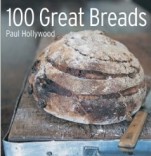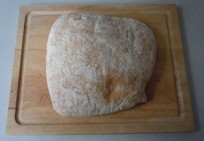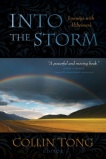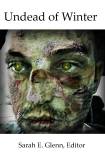 A few weeks ago I decided to try my hand at making ciabatta. I like to cook, and I’ve made bread before, but I’d never tried making this light, airy Italian bread. Normally, I just buy it from a favorite local bakery (which, I’m happy to say, recently reopened after a fire two years ago at the original location). For some reason, though, I decided I’d try baking something new. So I pulled out my copy of Paul Hollywood’s 100 Great Breads and looked up ciabatta.
A few weeks ago I decided to try my hand at making ciabatta. I like to cook, and I’ve made bread before, but I’d never tried making this light, airy Italian bread. Normally, I just buy it from a favorite local bakery (which, I’m happy to say, recently reopened after a fire two years ago at the original location). For some reason, though, I decided I’d try baking something new. So I pulled out my copy of Paul Hollywood’s 100 Great Breads and looked up ciabatta.
I thought I had all the ingredients I needed, but I discovered that my little packets of yeast contained far less than the recipe called for. Okay, I thought, I’ll make a half batch. Then I found a note in the “Tools, Techniques, and Tips” section of the book that told me to use 25 percent less yeast if I was using instant. I was. So now I had not only to halve the rest of my ingredients but then to increase them by 25 percent. My math brain was getting a little confused.
Add to this that Hollywood’s recipe said to use “a generous 1 1/2 cups of water,” which was to be divided in half. Generous? How much over 1 1/2 cups is generous? Another tablespoon? Another 1/8 cup? Well, whatever. I’d make it work.
The recipe said to start by whisking 2 cups of flour and the yeast with “a generous 3/4 cup of water.” I made the necessary mathematical adjustments for my half batch and put the ingredients in the bowl, using just a bit of extra water. As instructed, I began to whisk. The ingredients immediately clumped into a wad of dough in the middle of my wire whisk. Clearly, I had not been generous enough with my water. I extracted the dough from the middle of the whisk and added enough water to reach a reasonable whisking consistency.
After letting the mixture ferment for the required time, I added the remaining ingredients. This time I was more generous in my interpretation of “generous 3/4 cup.” I let the dough rest as instructed, then tipped it onto the counter to divide into two pieces and, as the recipe said, “stretch” it into loaves. Wait. What do you mean “stretch”? My mixture was oozing over the countertop. If I didn’t catch it, it was going to drip off the edge. Whatever I’d managed to create was not something I could stretch.
Okay, how to salvage? Well, add more dry ingredients, of course. Now, ciabatta is not supposed to be kneaded, but I didn’t know how else to mix additional flour with my oozing dough. So I kneaded. By this point, I was laughing. I had no idea how this bread was going to turn out, but I was determined not to give up on it.
It might help you to know that I was raised by a mother, an excellent cook, who taught me that recipes are just a suggestion. I frequently adjust or substitute ingredients to suit my taste or to use whatever I happen to have on hand. I do understand that baking sometimes requires a bit more precision than other types of cooking, but I was already in the thick of this. I figured I might well see it through.

The bread turned out okay, though it wasn’t exactly ciabatta. Thanks to my kneading, it was much denser, with tiny air bubbles instead of the pockets you find in the real thing. But it still smelled pleasantly yeasty, it still tasted good, and making it was an adventure.
One of my friends once told me that I am perhaps the most fearless cook he knows, because I will add, subtract, or substitute ingredients, or even make up my own recipes. He added that when I succeed, the results are delicious, and when I fail, I fail spectacularly. It’s true. The failures can be inedible. But I’m okay with that. I’m still willing to bend the recipe rules the next time I find myself in a situation where I don’t have the exact ingredients or the exact quantities.
I wish I had that same fearlessness when it comes to my writing life. Instead, I worry that I’m making the wrong choices. I don’t give myself the same freedom to succeed beyond expectations or to concoct a glorious failure. (See this post on my personal blog for more reflections on fear, failure, and freedom.) Perhaps that’s because, while I love to cook, I don’t define myself as a cook. And I do define myself as a writer. In reality, each is only one part of me, and I’m more than the sum of those two, or all, my parts. (This reminds me of Erin Farwell’s excellent post on writing and self-definition.) Maybe the answer is to release that identification of self, or self-worth, with the action, and to see writing, like cooking, as something I do, not something I am, to focus on “write” as a verb and not “writer” as a noun. That might make it easier to write about whatever I want or need to write about and let the writing succeed or fail on its own merits. Then I can embrace the joy and adventure of writing, learning both from my successes and my spectacular failures.
In what areas of your life are you fearless?
100 Great Breads book cover from Amazon
Connect with Stephanie Stamm:
http://www.stephanieastamm.com
Stephanie Stamm is the author of the New Adult/Young Adult urban fantasy A Gift of Wings.
Half-Seraph and skilled fighter, Aidan Townsend could no longer live with the consequences of being a celebrated member of the Forces of the Fallen. So he walked away from it all and created a human life—as singer/songwriter for a successful Chicago band. He keeps his angelic abilities hidden—even from himself. Lucky Monroe is about to turn eighteen, looking for a job, contemplating college, and coming to terms with her beloved grandmother’s descent into Alzheimer’s. When her cousin takes her to hear a popular local band, and she sees fiery wings extending from the back of the lead singer, Lucky is drawn into a world of Fallen angels, demons, and ancient gods. While eluding a supernatural stalker and surviving an attack by sword-bearing rogue angels, Lucky must figure out who and what she is willing to be, to save someone she loves.
She has also contributed stories (one fictional and one true) to the following volumes:



Stephanie, this was a perfect blog, it had all the right ingredients. I am a fearless cook too, and the same thing happens to me with it either being a masterpiece or a failure. The only thing is I expect my family to eat my failures, and they try hard, but sometimes it’s just not possible. Thanks for my morning chuckle. Love the link to Erin. Cher’ley
LikeLike
Wow, thanks, Cher’ley! I really appreciate your support–and being part of this group. Your comment about your family eating the failures gave me a morning chuckle too!
LikeLike
Great post Stephanie. My mother grew up on a horse farm and did all the cooking even as a small child so the others in the family could keep the outside work done. Like her mother, my mom was a “hit and miss” cook and her food was delicious. I turned out to be the one in the family who cooks like she did. I’m fearless in the kitchen, never afraid to try new things and enjoy “mixing up” recipes. I had a hard time being identified as an author but it finally sunk in and I feel the same way about writing as I do about cooking. If you don’t follow your heart you’ll never know if it works and think about how many people are in awe of the fact that you write!
LikeLike
Thanks, Linda! It’s good to hear that the fearlessness can migrate to other areas of life given time.
LikeLike
Wonderful, Stephanie, I remember trying your concoctions back when we were roomies and don’t remember any failures. 🙂 It’s interesting that there are places in our lives where we can be fearless and others where we hold ourselves back. For me it depends on how much I think I’m showing my “true self” which occurs in my writing and therefore is much scarier. Still, I grow, I learn, I keep typing. Thanks for the great post and the shout out.
LikeLike
Thanks, Erin. I’m glad I didn’t subject you to any of the attempts that ended up in the garbage. 🙂 And, yes, I agree that it has to do with the sharing or showing of the “true self.” Putting who we really are out there for all to see can be downright terrifying. But we gotta do it to feel alive. So I too keep typing, keep learning, and keep growing.
LikeLike
The nice thing about writing is that especially with the help of computers, if you make a mistake, it’s easier to fix it. Happy cooking.
LikeLike
Thanks, Abbie. Yes, I’m thankful that I’m writing in the days of computers instead of manual typewriters!
LikeLike
Stephanie,
I can so relate to you way of cooking. It is a lot more fun that way. Actually the whole experience I related to on so many levels. We may be writers, but we write for a living…
I am sure chefs make mistakes also. Keep up the good work and meet you at the oven. (Grin) Doris
LikeLike
Thanks, Doris. Cooking is more fun that way–and, yes, we all make mistakes. It’s just part of being human, isn’t it? We just have to roll with it.
LikeLike
I make a lot of cooking adaptations and often surprise myself with edible results. The opposite is also true, and like my writing, I just hope the rubbish bin will not be the only beneficiary. I hope even a taster will please someone.
LikeLike
I also meant to add it was fun reading your description, Stephanie- thank you. 🙂
LikeLike
Thank you, Nancy. Your comment about the rubbish bin reminds me that one of things we have all learned as writers is that sometimes even good stuff has to be thrown away–because it doesn’t fit a particular story. Sometimes that rubbish can be used somewhere else, and even if it can’t it may provide some kind of compost.
LikeLike
Wonderful post, Stephanie! I think it takes a lot of courage to cook (especially to try unique things like your bread), to create art, and to write. Doing all these things “puts us out there”, and we can/are criticized by others as well as ourselves. Yet, life in general takes courage because anyone can fail at anything at any time. May we write (or create food, jewelry, paintings) with courage, putting ourselves out there, for as you so eloquently point out, the results can be delicious!
LikeLike
Thank you, Gayle. Courage is exactly right. We all have to summon the courage to risk failure in whatever we do. That’s what enables us to live. I half-watched the movie When in Rome the other night. The movie is just okay, but it did have one very memorable line: “The passion is in the risk.”
LikeLike
Absolutely loved this post. I love to bake bread from scratch. In the beginning, yeast was such a mystery to me. I worked and worked with it until I can now pretty much know how it’s going to react in my flour mixture. I’m really wanting to know how to make a crusty French bread in a conventional oven. My dream would be to have a wood-fired brick oven in my backyard. Any ideas on crusty breads? Stephanie, I truly loved this post!
LikeLike
Thanks, Sherry. Wood-fired oven in your back yard? How cool would that be?! You could make pizzas. Nothing like a wood-fired pizza. Crusty breads? Hmmm… Really I haven’t made all that many different kinds. I do recommend the almost no-knead from Cook’s Test Kitchens. It actually bakes in a dutch oven, lid on for a while and then off for a while.
LikeLike
. Each word is an ingredient in a story. Before it is ready to go into the oven ( someone else hands) You need to make some adjustments. Like bread or any other baked item when a story is finished and determined to be a major fail you can toss it out and try again. Thanks for sharing I loved the story about the bread.
LikeLike